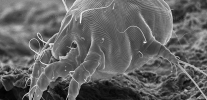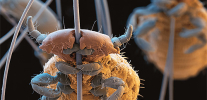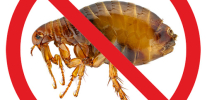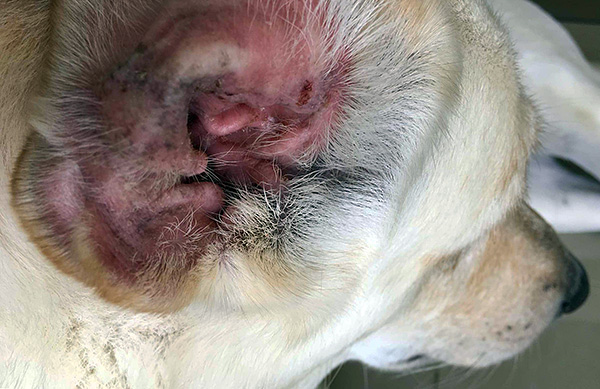
The ear mite Otodectes cynotis is one of the most dangerous and common parasites of dogs and cats around the world. It occurs in almost all countries of the globe, regardless of the type of climate.
Millions of animals suffer from ear scabies every year, and in addition to dogs and cats, Otodectes cynotis parasitizes other small carnivorous mammals, including ferrets and foxes. According to statistics, about every third domestic animal is a carrier of ear mites, and among stray animals, this figure reaches 90%.
The photo below shows how the adult individual Otodectes cynotis mite looks like under a microscope:

On a note
The mite affects the ear canal, the eardrum and the inner ear, resulting in the development of purulent otitis and dermatitis, accompanied by severe itching, as well as pain. The danger of infection with an ear mite is that it is almost impossible to immediately notice the fact of infection,and usually the owners notice the parasite already at the stage of intense manifestation of the symptoms of the disease. When postponing veterinary care, the disease is aggravated by inflammatory and purulent processes, which often leads to the death of the animal.
Most dogs become infected from their street kin (during walks). The tick is transmitted very quickly - a single short-term contact is enough to transfer several individuals of the parasite to the skin or coat of the animal.
There are rare cases of human tick infestation. In humans, the parasite also causes itching and inflammation of the middle ear.
What is dangerous in the presence of an ear mite in a dog?
Otodectesis is a chronically occurring disease, and its danger to the health of the dog is higher, the longer the life of the ear mite in the auditory passages of the pet lasts.
Otodebtovyh mites damage the skin in the ears and feed on the secretions from the wounds - lymph and suppuration products. As a result, severe inflammation occurs, accompanied by pain and intense itching. In areas of parasitization, significant accumulations of waste products of mites (feces, chitinous integument,remaining after molting), which are mixed with pus, dead tissue, earwax and particles of the epidermis, because of which in the ear canal of the dog in abundance accumulates a dark brown mass that forms a tube.
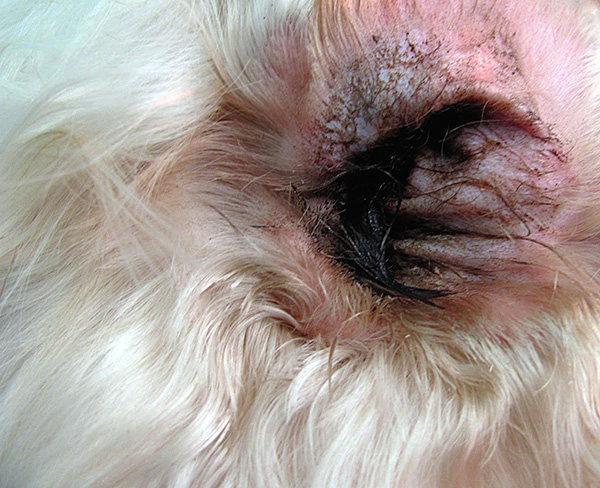
The animal furiously combs its ears, additionally injures them and pollutes, because of which there are pockets of breeding bacteria, often turning into purulent otitis. This is followed by severe inflammation of the eardrum, its perforation occurs (holes are formed in it), and the inflammation passes to the inner ear and then to the meninges. Usually in the absence of treatment of otodecosis, dogs die due to purulent meningitis.
On a note
As a rule, the dog after infection with an ear mite is not much worried about the primary symptoms, manifested in the form of a still relatively mild itch. Inflammatory reactions, caused not only by active feeding of ticks, but also by the reproduction of microorganisms in the affected skin areas, cause much more severe irritation. Therefore, treatment should be directed both to the destruction of parasites and to the disinfection of wounds and the reduction of animal pain.
Curious nuances of the parasite's vital activity
The size of an adult ear mite does not exceed 0.5 mm; therefore, the parasite can be examined in detail only under a microscope:
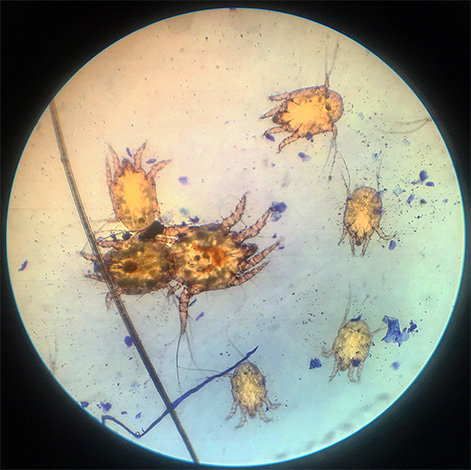

These parasites are characterized by a rounded body, with females slightly larger than males. The oral apparatus has sharp chelicera, with which the mite literally cuts the skin of the victim.
Eggs whitish-gray, oval, reach 0.3 mm. The female lays them in the ears or on the coat of the sick dog. After a short period of time, small larvae emerge from them - they are distinguished from adults by three, rather than four pairs of legs.
Next, the larvae molt into nymphs, which in turn turn into imago. The full developmental cycle (from egg to mature individual) lasts about 3 weeks.
The photo below shows the ear mites in the focus of invasion:

On a note
At any stage of their life cycle, ear mites can be transferred from one animal to another. Eggs scatter very quickly in coat, especially when the animal is combing the affected areas. In fact, the sick dog spreads eggs, larvae and adult parasites everywhere, so timely treatment of the pet and de-sacrification of the room where it lives is very important. Hitting literally a pair of eggs or larvae on a healthy dog is fraught with possible infection.
Typical symptoms of ear ticks in dogs
Aural scabies is manifested by a sharp systematic itching in the area of the auricle and the ear canal. Because of this, the dog strongly and often shakes his ears and head, combs the auricles with paws. Sometimes the disease quickly goes into a stage of purulent otitis.

On a note
Although ear scabies and purulent otitis are often identified, it is relatively easy to distinguish them even at home (it is important to choose the direction of treatment, because before starting it, it is necessary to understand what caused the disease). Classical otitis is not preceded by prolonged itching, animals do not comb their ears, as they experience severe aching pain in the ear canal. The nature of the discharge from the dog's ears is also significantly different: when a tick is infected, there is a dark brown viscous mass, it smells foul, crusts form, while with otitis media, the excretions are usually relatively liquid, are derivatives of suppuration.
If the disease is not detected in the initial stages,inflammation can lead to perforation of the eardrum. This is followed by inflammation of the inner ear, followed by the upper shells of the brain.
The following are the main symptoms that occur when a dog is infected with an ear mite:
- animals shake their heads sharply, often scratching their ears;
- whine;
- there are pathological changes in the statement of the head (dogs tilt their heads, turning the sore ear down);
- pet becomes irritable;
- sleep is disturbed, the dog eats badly;
- puppies are not gaining weight;
- sometimes there is an increase in body temperature.
It is interesting
The disease often occurs in a chronic form. Itching may occur sporadically - due to the temporary activity of ticks. Sometimes the symptoms of otodecosis in a dog are very mild, but it can infect other dogs with which it contacts.
As noted above, the disease is often complicated by the accompanying microflora. At the same time, the breeding bacteria can create unfavorable conditions for the otodect mites, and after a while the population of parasites in the auditory canals of a dog may even decrease significantly due to this.When treating in such cases, great attention is paid to the destruction of the foci of staph infection.
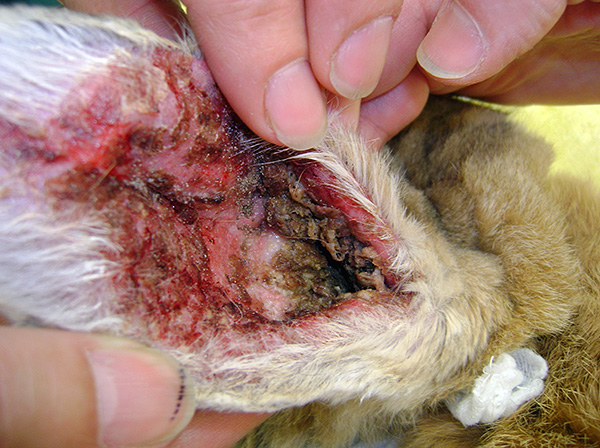
When treating otodecosis in dogs, one should not rely only on one’s own strength or seriously rely only on traditional methods of treatment - it is important to consult a specialist in time. The final diagnosis is made after laboratory tests of the discharge from the dog's ear (with a microscope, ticks are detected in them).
It is important to understand that due to the small size of the parasites and their large number, simply pulling out or somehow washing the ticks out of the auditory canal will not work. In this situation, only drug treatment is effective, which should begin after consulting a veterinarian.
How does infection usually occur?
In dogs, otodectes is constantly recorded in all parts of Russia, but this disease does not reach the scale of epidemics. Usually, foci of otodectes are locally distributed, their boundaries correspond to farms, fur farms, and also sleeping quarters, where a large number of stray animals gather.

This tick-borne disease does not have seasonal timing - dogs get sick at any time of the year.
On a note
The lack of seasonality in the life cycle of otic mites is an additional problem in the prevention and treatment of otic and subcutaneous acarosis, since infection can occur even in winter, when there are severe frosts outside.
If ixodic ticks (those that attack people and animals in the forest) are active only in the warm season, then acariform ticks do not have diapause and are able to reproduce throughout the year. This is explained by the fact that ixodic ticks are temporary external parasites, and therefore are highly dependent on the conditions of their environment, whereas ear ticks live only inside the ear canal, where the microclimate is always favorable for them.
However, despite the fact that the ear scabies does not show signs of obvious seasonality, the greatest number of cases of infection of dogs still falls on the autumn-spring period, when the air is rather humid. And among urban animals living in apartments, the peak of invasions occurs in the summer, when pets are actively taken out for walks in nature.
Otodectesis occurs in dogs of different age categories. Young people aged from 1.5 to 5 months are most affected, while the disease in puppies often goes away in a complicated form. Puppies are usually infected from the mother.

The most sensitive to ear ticks are dog breeds with long ears, especially hunting ones, to which the tick can pass from patients with otodectes of foxes, arctic foxes, ferrets and other predators. Also, relatively often, ear mites are found in:
- tax
- Spitz;
- french bulldogs;
- Chihuahua;
- yorkies;
- German Shepherd Dogs
Healthy animals in apartments and farms are infected through:
- contacts with sick dogs and cats (even short contacts on the streets are enough while walking - for example, when sniffing);
- objects of care that contaminated animals touched (ticks and their eggs remain on combs, bowls, bedding, toys of cats and dogs, so if there are several animals in the apartment, then an individual approach to their hygiene is very important);
- clothes and skin of a person who touched patients with ear-scab animals;
- flies and fleas, which are the mechanical carriers of Otodectes cynotis eggs.
The photo below shows the accumulation of ear mites in a sample of discharge from a dog's ear:
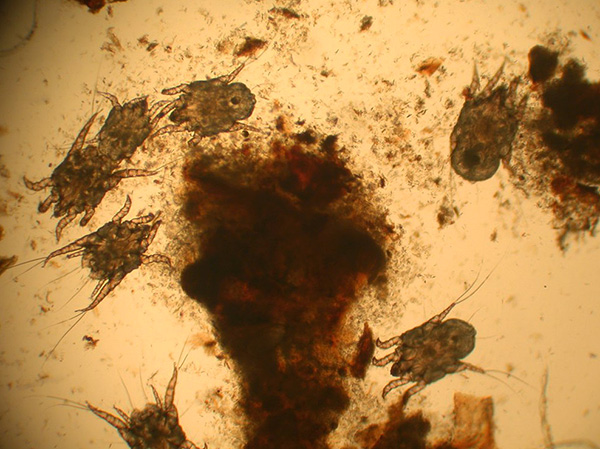
For humans, the ear mite is relatively safe, however, there are several cases of infection by people with an otodect tick. In the human aisle, this parasite can live for several months, causing severe inflammation of the middle ear.
Sometimes the tick can feed not on the ears, but on other parts of the body of people - where there is thin skin (axilla, groin, neck). The reasons for moving the ear mite to a person are not completely clear, but the fact that the parasite can be dangerous for people should not be overlooked. In order to avoid such an unpleasant neighborhood, it is necessary to adhere to elementary hygiene rules and minimize contact with stray and sick animals.
The algorithm for the treatment of ear mites in dogs
When treating dogs for ear mites, various acaricides are used, and the first thing to pay attention to is the variety of forms of drugs.

So, there are four main types of anti-tick medicines:
- sprays;
- drops;
- ointment;
- powders.
Most of them are quite suitable for use at home, but before using this or that drug, you need to consult with a veterinarian. Firstly, only a specialist can make a final diagnosis, and secondly, the choice of drug and concentrations will largely depend on the intensity of infection (how much otodectes are started).Thirdly, it is also often necessary to relieve the accompanying symptoms of the disease caused by its complications.
Despite the significant difference in approaches to the treatment of ear mites, there is a certain sequence of actions that should be followed.
First you need to limit the contact of a sick animal with a healthy one. It is useful to wash the dog regularly and thoroughly, but make sure that the water does not get into the ears. Before administering medications, the ear canal must be cleaned of secretions and crusts. To do this, you need to pour a saline solution into your ear (either a chlorhexidine solution or a special lotion to clean the ears), wait about 5 minutes, and then very gently massage and clean the softened mass with a cotton swab. Only after that you can proceed to the introduction of the drug.
An example of a good lotion for cleaning ears in cats and dogs - Otifri:

On a note
It should be borne in mind that a massage in the auricle area of a patient with a dog otodectesis can cause significant pain, so this procedure should be carried out as carefully as possible, without undue pressure.
Drops are introduced into the ear canal with a pipette, after which the base of the ear is again subjected to a light massage. If an ointment is applied, this is done with a tampon. The powders are gently poured into the auricle and distributed with a cotton swab (without deepening into the ear canal). Also very convenient are sprays that are sprayed into the ear and on the animal's fur according to the instructions.
Drops and sprays are considered to be the most effective preparations for ear ticks, which give quick results, since they contain a greater concentration of active substances and effectively penetrate into the focus of the disease. In some cases it is possible to combine the means - for example, the simultaneous use of spray and ointment.
Do not forget about the possible complications of the disease due to concomitant microflora. In some cases, in addition to the external use of acaricides, intramuscular administration of antibiotics may be necessary.
On a note
Separately, it should be said about some folk remedies that are often trying to deal with an ear mite. For example, you can often find recipes based on oily substances (olive and sunflower oils, kerosene), which are mixed with caustic ingredients (garlic juice, iodine).It is assumed that the oil, falling into the ears, will envelop and suffocate the tick, and garlic or iodine - to disinfect the inflamed ear from bacteria.
However, it should be borne in mind that garlic juice, iodine and kerosene can cause chemical burns of the skin, thereby intensifying severe irritation in places of parasitization of ododex. If such mixtures get deeply into the ear canal (especially if the eardrum is already perforated), the animal may become irreversibly deaf.
Thus, when infecting a dog with an ear mite, the use of drugs will be the most effective, safe and quick treatment option. Without the intervention of a veterinarian, the disease threatens with serious complications, often leading to disability of the dog, and sometimes to death.

Let's now look at examples of some drugs that are used today to treat dogs with otodecosis.
Effective drugs used to treat otodecosis in domestic animals
When ridding a dog of an ear mite, it is important not only to quickly begin treatment, but also to choose a truly effective drug that will destroy the parasites and help reduce the severity of the unpleasant symptoms associated with the illness.
Today, there are a large number of high-quality drugs (primarily ear drops and sprays), which, in addition to acaricides and antimicrobial components, also contain anesthetic and anti-inflammatory substances. Consider some of them:
- Amit's ear drops are a contact medication that acts locally in the breeding center of ear mites. The drug does not penetrate the skin, is non-toxic, has anti-inflammatory and healing properties, has many positive reviews;
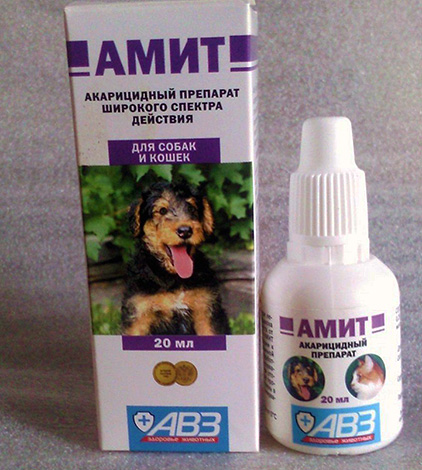
- Anti-parasitic spray Acaromectin - has neuroparalytic properties against ticks and insects (when it hits the body of the parasite, it blocks the activity of its nerve nodes). The drug can be used to fight the ear parasites in the ear canal, and to destroy them in other parts of the body;

- Demos are potent ear drops, the main counter-mite component of which is sulfur dissolved in carbon tetrachloride. Due to the high activity of the drug can not be used for the treatment of pregnant and lactating females, as well as puppies under the age of four weeks (most often the disease occurs already at this age);
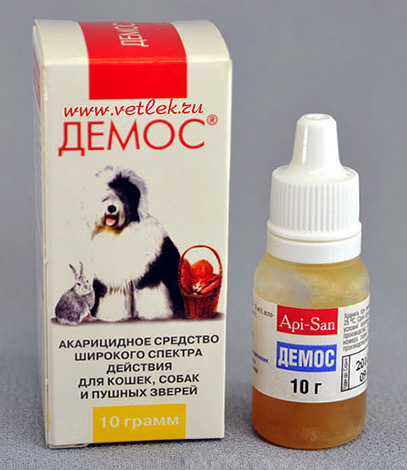
- Dekta - ear drops complex action on the basis of amitraz (acaricide), chloramphenicol (antimicrobial agent) and propolis (antimicrobial, anti-inflammatory and wound-healing agent);

- Bars ear drops - contain only one active ingredient (diazinon), which simultaneously has acaricidal, anti-inflammatory and antimicrobial action. It is important not to confuse these drops with Leopard drops from fleas and ticks (on withers);
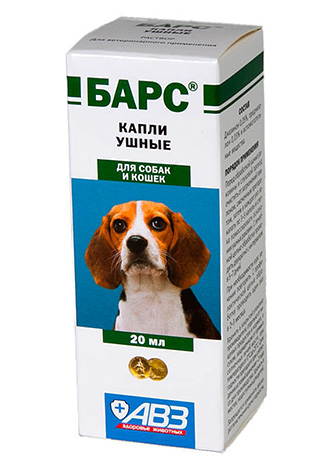
- Zipam ear drops are based on cypermethrin and amitraz, which quickly destroy ticks, fleas, lashes and other parasites. In this case, the drug is not absorbed into the blood of the sick dog.
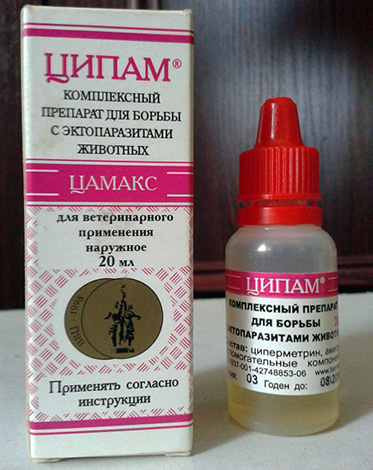
This list contains only some of the really effective and time-tested drugs that can quickly cure a dog from ear scabies. Moreover, this does not mean that they will best suit exactly in your case - only qualified treatment under the supervision of a specialist will help to achieve the desired result as soon as possible.
Otodecosis prevention measures
In addition to medical treatment, it is necessary to remember about the sanitary condition of the apartments, as ticks and their eggs very quickly dissipate throughout the room,and if they are not destroyed here, then after some time, an infection of a seemingly cured animal can occur again.

It is useful to boil all the fabric items of the animal (bedding, clothes, toys), to wash and dry all bed linen in the house in the sun. Spring cleaning twice a week using available disinfectants.
Do not allow the treated animal to come in contact with bed linen. More often air the apartment. In winter, “freezing out” large carpets with a long nap, sofas, and chairs can be effective. Booths and dog care items should be treated with any acaricidal agent. To avoid re-infection, it is necessary to monitor the dog while walking, not to allow it to stray animals.
If you have personal experience in treating a dog for ear mites, be sure to share the information by leaving your review at the bottom of this page. How your pet has a disease, whether you went to a veterinarian or treated yourself, what drugs were used and whether the dog was cured - any information would be useful for subsequent readers ...
Useful video: how to quickly and effectively treat otodectosis in dogs and cats
And this is how moving ticks look in the auricle at high magnification

